Key takeaways:
- Community recycling projects foster connection and unity among residents, encouraging collective action toward sustainability.
- Local initiatives empower individuals, especially children, to take ownership of their environmental responsibilities and inspire future leaders in sustainability.
- Effective engagement strategies, such as hosting lively events and leveraging social media, significantly boost community participation and awareness.

Understanding community recycling projects
Community recycling projects are fascinating initiatives that bring people together to tackle waste management and environmental challenges. I still remember the first time I participated in a local recycling drive. It was a crisp Saturday morning, and I felt a surge of excitement knowing I was making a difference alongside my neighbors. Have you ever felt that sense of purpose when contributing to something larger than yourself?
These projects often transform neighborhoods, fostering a sense of camaraderie and responsibility among participants. I recall how, during one event, we not only collected recyclables but also exchanged stories about our sustainable practices. That connection deepened my understanding of how vital these projects are—not just for the environment, but for building community ties. Isn’t it incredible how a simple act of recycling can create bonds and inspire change?
Moreover, the educational aspect of community recycling projects cannot be overlooked. I’ve attended numerous workshops that opened my eyes to the complexities of waste segregation and the importance of reducing contamination. These experiences often leave me pondering: how can we better educate our communities about the impact of their recycling habits? Understanding the lifecycle of materials encourages thoughtful consumption, and I believe this knowledge is key to fostering a more sustainable future.

The importance of local initiatives
Local initiatives play a crucial role in addressing waste management challenges. I remember volunteering for a community garden project that later led to a recycling initiative. Watching residents bring in their old plastic bottles while sharing stories about their gardens sparked conversations about sustainability. This connection shows how local projects can birth new ideas and collaborative efforts, transforming our neighborhoods into eco-friendly spaces.
Additionally, local initiatives empower residents to take ownership of their environment. During one recycling event, I witnessed a group of children eagerly collecting cans and bottles, inspired by their parents. It was heartwarming to see the younger generation actively participate, instilling in them a sense of responsibility. This generation will be our future leaders in sustainability, and local initiatives can plant those vital seeds of awareness early on.
Moreover, I can’t stress enough how these projects often provide educational opportunities tailored to the community’s needs. I attended a workshop led by a local activist who presented eye-opening statistics on waste reduction. It blew my mind! Engaging our community through tailored education can significantly improve recycling rates and awareness, creating a ripple effect that benefits us all.
| Key Benefit | Description |
|---|---|
| Community Engagement | Fosters relationships and collaboration among residents. |
| Ownership | Empowers individuals to take pride in their local environment. |

My first recycling project experience
I vividly remember my first recycling project experience. It was a small gathering organized by our neighborhood association, and I wasn’t quite sure what to expect. As I arrived, I felt a mix of nervousness and excitement. It turned out to be a warm, welcoming event where the community came together, armed with bags of recyclables. I was surprised to find that I wasn’t just here to collect items; I was stepping into a space filled with laughter, shared stories, and collective determination to make a difference.
- That first day, I recall holding up a plastic bottle and feeling a sense of empowerment, as if I were clutching a tiny piece of our planet’s future.
- The sense of unity was palpable, as neighbors exchanged tips on how to reduce waste in their homes, transforming the project into a mini-workshop.
- I left that first recycling project not only with a bag of recyclables but with a deeper appreciation for community efforts and the power of collective action. Each conversation sparked a newfound commitment in me to be a more responsible consumer.
During that experience, I also noticed something unexpected: the joy that recycling can bring! Watching families of all ages working side by side was heartwarming. I remember a young girl proudly showing off her collection of bottle caps, sharing her dream of turning them into art. That sparked a realization for me—recycling isn’t just about waste management; it’s also about creativity and hope for a sustainable future.

Challenges faced during projects
I’ve faced several challenges while participating in recycling projects that really tested my patience and creativity. One memorable instance was during a neighborhood clean-up day when we discovered that some residents were confused about what could or couldn’t be recycled. It was frustrating to see perfectly good materials tossed into the non-recyclable bin. This led to uncertainty not just about recycling, but also about how effective our efforts truly were. How could we fix the confusion? Well, that sparked the idea to create simple, color-coded flyers and put up informative signs at our collection points.
Another difficulty cropped up when it came to gathering volunteers. I found myself disappointed when the expected turnout was much lower than anticipated, especially on days when the weather wasn’t ideal. I often wondered, why is it challenging to get people motivated? It prompted me to reflect on the necessity of making these events fun and engaging. For our next project, I proposed adding a friendly competition element, which ultimately helped boost participation. Connecting through small games or rewards can ignite a sense of excitement, turning a chore into a communal celebration.
Lastly, one of the most profound hurdles I encountered was dealing with the inevitable frustration of debris… and lots of it! Sorting through piles of broken glass and organic waste during one project was not only labor-intensive but also somewhat disheartening. It made me question whether our recycling efforts could make a dent against such overwhelming waste. After a day of hard work and scrapes, I realized this challenge was a necessary part of the process; it highlighted the urgency of community awareness. Each piece we sorted became a reminder of why we started these projects in the first place—and that’s how lasting change begins.

Effective strategies for community engagement
Engaging the community effectively requires understanding the heart and soul of your neighbors. I’ve found that hosting a kickoff event, complete with food and entertainment, draws people out of their homes. Who can resist a lively gathering? I remember one particular Saturday when a local band performed at our launch. It felt like a mini-festival, and the energy was contagious! Folks who might have just walked by started volunteering their time, and that unexpected enthusiasm was a game changer.
Another strategy that has proven invaluable is leveraging social media platforms. When I shared updates about our recycling initiatives online, I noticed an incredible spike in interest. It’s like opening a window into our efforts; people can see the impact of their involvement in real-time. I distinctly recall receiving a message from a neighbor who decided to organize her own collection event after witnessing our progress. Isn’t that powerful? Your enthusiasm can inspire others to take action too.
Creating educational workshops has also been a rewarding approach I’ve tried. I remember hosting a session on how to repurpose materials into something beautiful; it fueled creativity in unexpected ways. People were excited to learn, asking questions and sharing their own tips. These moments showed me that when you equip community members with knowledge, they naturally become more invested in the cause. After all, how much more likely are we to engage when we feel empowered and informed?

Measuring project success and impact
Measuring the success and impact of recycling projects can sometimes feel daunting, but I’ve found that simple metrics can tell a powerful story. One effective way I’ve approached this is by counting the amount of recyclable materials collected over time. I remember the thrill of seeing our collection numbers grow each month. It was more than just data—it was a tangible sign that our efforts were resonating with the community. Have you ever felt that rush of excitement when witnessing progress? It’s contagious and motivates everyone involved.
Another way to gauge success is through community feedback. I recall organizing a survey after one of our larger clean-up events. The results were eye-opening! Beyond the numbers, hearing personal stories from neighbors about how the project influenced their recycling habits made the data come alive. It reminded me that success isn’t just about statistics; it’s about changing perspectives and behaviors. How powerful is it to know that your initiative has sparked meaningful change in others’ lives?
Lastly, I’ve learned that setting long-term goals helps measure lasting impact. During one project, we aimed to reduce overall waste in our neighborhood by 20% within a year. Tracking our progress became both a challenge and an inspiration. Each month, we celebrated small wins, like when our waste diversion rate reached 15%. I’ll never forget the community meeting we held to discuss our findings; the enthusiasm in the room was palpable. It was a moment that drove home the idea that collective accountability breeds success. Don’t you think it’s incredible how a shared vision can elevate community spirit?
















